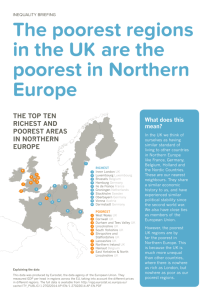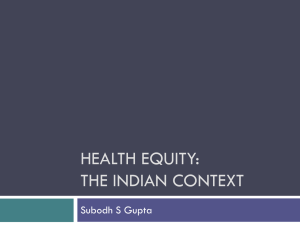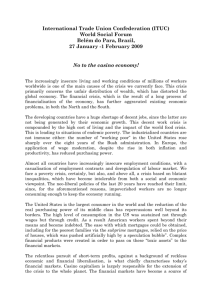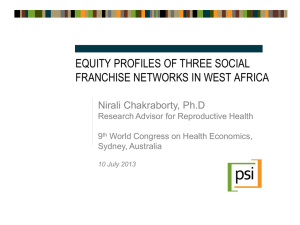improving the health of the world's poorest people
advertisement
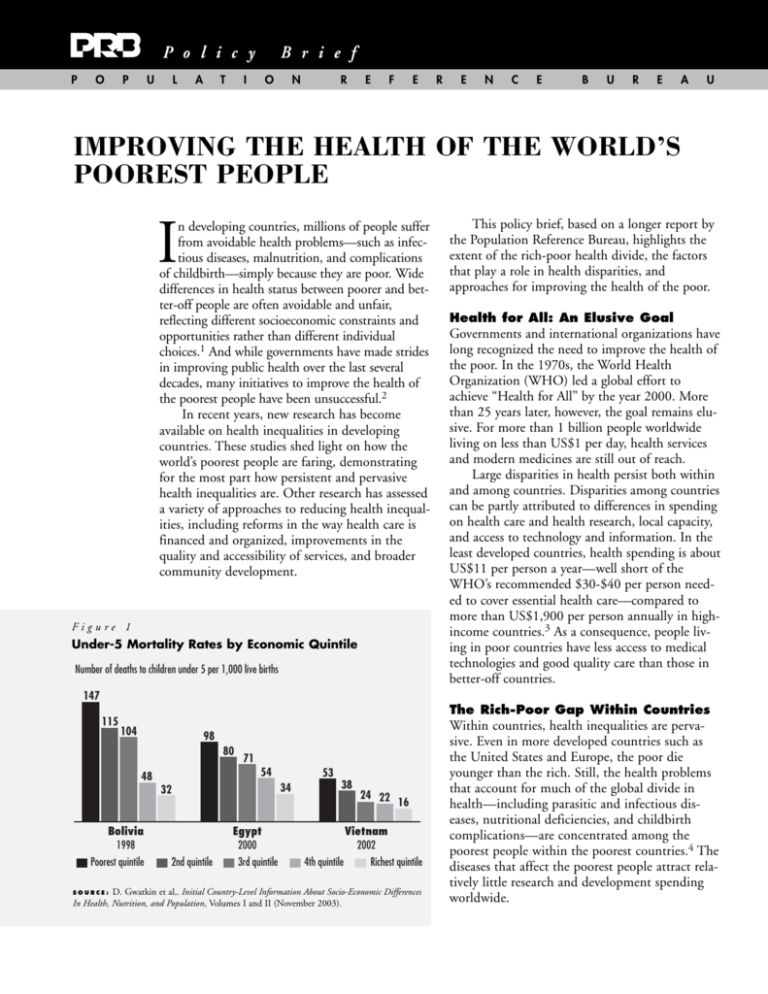
P o l i c y P O P U L A T B r i e f I O N R E F E R E N C E B U R E A U IMPROVING THE HEALTH OF THE WORLD’S POOREST PEOPLE I n developing countries, millions of people suffer from avoidable health problems—such as infectious diseases, malnutrition, and complications of childbirth—simply because they are poor. Wide differences in health status between poorer and better-off people are often avoidable and unfair, reflecting different socioeconomic constraints and opportunities rather than different individual choices.1 And while governments have made strides in improving public health over the last several decades, many initiatives to improve the health of the poorest people have been unsuccessful.2 In recent years, new research has become available on health inequalities in developing countries. These studies shed light on how the world’s poorest people are faring, demonstrating for the most part how persistent and pervasive health inequalities are. Other research has assessed a variety of approaches to reducing health inequalities, including reforms in the way health care is financed and organized, improvements in the quality and accessibility of services, and broader community development. Figure 1 Under-5 Mortality Rates by Economic Quintile Number of deaths to children under 5 per 1,000 live births This policy brief, based on a longer report by the Population Reference Bureau, highlights the extent of the rich-poor health divide, the factors that play a role in health disparities, and approaches for improving the health of the poor. Health for All: An Elusive Goal Governments and international organizations have long recognized the need to improve the health of the poor. In the 1970s, the World Health Organization (WHO) led a global effort to achieve “Health for All” by the year 2000. More than 25 years later, however, the goal remains elusive. For more than 1 billion people worldwide living on less than US$1 per day, health services and modern medicines are still out of reach. Large disparities in health persist both within and among countries. Disparities among countries can be partly attributed to differences in spending on health care and health research, local capacity, and access to technology and information. In the least developed countries, health spending is about US$11 per person a year—well short of the WHO’s recommended $30-$40 per person needed to cover essential health care—compared to more than US$1,900 per person annually in highincome countries.3 As a consequence, people living in poor countries have less access to medical technologies and good quality care than those in better-off countries. 147 115 The Rich-Poor Gap Within Countries 104 98 80 71 54 48 32 Bolivia 1998 Poorest quintile 53 34 38 Egypt 2000 2nd quintile 3rd quintile 24 22 16 Vietnam 2002 4th quintile Richest quintile S O U R C E : D. Gwatkin et al,. Initial Country-Level Information About Socio-Economic Differences In Health, Nutrition, and Population, Volumes I and II (November 2003). Within countries, health inequalities are pervasive. Even in more developed countries such as the United States and Europe, the poor die younger than the rich. Still, the health problems that account for much of the global divide in health—including parasitic and infectious diseases, nutritional deficiencies, and childbirth complications—are concentrated among the poorest people within the poorest countries.4 The diseases that affect the poorest people attract relatively little research and development spending worldwide. Figure 2 Health Inequalities in Less Developed Countries, 1990-2002 Average ratio of rate in poorest quintile to rate in richest quintile 2.2 3.2 1.9 health, other studies have found statistically significant relationships (associations that are not due to chance) between economic status and child health. One study of childhood nutrition in 20 developing countries found that 18 countries had statistically significant inequalities in stunting and underweight, two international measures of malnourishment.5 Inequalities in the Use of Health Services Under-5 mortality rate (56 countries) Women malnourished* (45 countries) Children stunted† (50 countries) N O T E : Averages are not weighted for population size. * BMI <18.5, defined as weight in kilograms divided by the square of height in meters. † Low height for age in relation to an international reference population of well-nourished children. S O U R C E : D. Gwatkin et al,. Initial Country-Level Information About Socio-Economic Differences In Health, Nutrition, and Population, Volumes I and II (November 2003). One of the most extensive studies to date on health inequalities in less developed countries uses data from Demographic and Health Surveys (DHS) conducted in 56 countries in Africa, Asia, and Latin America. The surveys cover a range of population and health issues and measure socioeconomic status by inquiring about household assets and services, such as possession of a refrigerator, television, or motor vehicle, and the household dwelling’s construction, plumbing, and electricity. Researchers constructed a household wealth index from this data and divided the population in each country into five groups of equal size, or quintiles, based on individuals’ relative standing on the household wealth index within the country. The DHS analysis shows that the poorest quintiles fare worse than the wealthiest quintiles on a range of health outcomes, including childhood mortality and nutritional status. Figure 1 (page 1) shows childhood mortality levels by wealth quintile in Bolivia, Egypt, and Vietnam, reflecting this association. Among all of the countries included in the study, a child from the poorest wealth quintile is twice as likely on average as a child in the richest quintile to die before age 5 (see Figure 2). The disparity is similar in maternal nutrition, with women in the poorest quintile about twice as likely as those in the wealthiest to be malnourished, and more pronounced in stunting (low height for age) among children. Although the DHS analysis was not designed to establish a causal link between wealth and 2 PRB Improving the Health of the World’s Poorest People 2004 The DHS study shows that the poorest are also less likely than the wealthiest to use basic health services such as immunization, maternity care, and family planning. On average, children in the wealthiest quintiles are twice as likely as those in the poorest quintiles to have received all of the basic childhood vaccinations. The use of professional health care during childbirth varies considerably. Births to women in the richest quintile are nearly five times more likely, on average, to be attended by a trained professional such as a doctor, nurse, or midwife. Professional assistance at delivery is critical for maternal health, because most of the serious childbirth complications cannot be predicted in advance. The rich-poor gap is also wide for modern contraceptive use. On average, married women in the wealthiest quintile are more than four times more likely than those in the poorest quintile to use contraception. This may reflect disparities in access to family planning services as well as different levels of demand for contraception. Poor women who are often less educated, for instance, tend to want larger families than better-off, moreeducated women. Explaining Disparities Between the Rich and Poor In general, the poor are disadvantaged in all of the determinants of health. They are more vulnerable to ill-health and disease because of a lack of financial resources, limited knowledge of health matters, and limited use of health services. The better-off tend to use health services more frequently; rely on trained health professionals rather than traditional practitioners; and have smaller, better nourished families. Education—especially women’s education—figures prominently in household practices and behaviors related to good health. Community factors, including environment and geography, also disadvantage the poor in relation to health. People living in underserved, rural, and remote areas have less access to clean water, safe housing, and efficient transportation. In poor communities, social norms—including early age at marriage, large family size, and discrimination against women—are more likely to support behaviors associated with poor health.6 Also, the poor receive fewer benefits from the health system than do the better-off. The poor are more likely to find that health services are unavailable, inaccessible, too expensive, or of relatively low quality. Often, governments allocate the highest proportion of their health budgets to urban hospitals, leaving rural residents without adequate health facilities. Many governments have supported free or subsidized health services to improve health conditions among poor and vulnerable people, as part of a countrywide strategy to reduce poverty.7 In a number of countries, however, the poor are not benefiting as much as better-off groups from public spending in health. One study of seven African countries found that in every country, the poorest one-fifth of people received less than onefifth of the spending on curative health care.8 As for primary-level services, such as those provided at basic clinics and dispensaries, the poorest people benefited less than better-off groups in five of the seven countries. Approaches That Benefit the Poor Researchers generally agree that effective responses to health disparities can be found in many sectors, including health, education, finance, environment, agriculture, transportation, labor, and other sectors. A range of interventions, if carefully designed, can work toward reducing inequalities in health and health care. Enacting Pro-Growth and Pro-Poor Policies Often, rising incomes means growing inequalities, as the rich benefit more from technological change than the poor. To counter this effect, policies that promote economic growth should be accompanied by social policies in areas such as education, labor, and primary health care, and by special measures to ensure that the benefits of programs flow to the poor.9 Investing in Education Education (especially universal primary education) helps reduce health inequalities because it enables people to obtain safer, better jobs, have better health literacy, take preventive health care measures, avoid riskier health behaviors, and demand more and better-quality health services. Directing More Health Benefits Toward the Poor Because the poor tend to use health services less than the rich, public health programs may use “targeting” strategies to direct more benefits toward the poor. These strategies may identify who is poor and therefore eligible for certain benefits, or they may direct programs toward certain areas where poorer people live, or address specific health problems that the poor tend to suffer. Programs using multiple approaches may be most effective.10 In places where governments charge user fees for public health services, the ability to administer waivers or sliding-scale fees is critical to the success of directing benefits toward the poor. Promoting Primary and Essential Health Care The “essential services” approach means providing a basic package of cost-effective health services to everyone. Though financed by the government, private-sector health providers may deliver the services.11 Increasing the Availability and Quality of Health Services A common prescription for health systems is to direct more resources toward primary-level facilities and care, to increase and strengthen these services so that more people in neglected areas can benefit. Developing Public-Private Partnerships Since many nongovernmental organizations(NGOs) already work closely with the poor, governments may opt to support them to deliver health services to poor and vulnerable segments of society. Mobilizing Community Resources Recent projects in India and Ghana have mobilized community resources in innovative ways to improve the health of the poor. These approaches have included intensive training of communitybased health workers, the involvement of traditional leaders, and local delivery of services. Some PRB Improving the Health of the World’s Poorest People 2004 3 For More Information projects have achieved dramatic results by reorganizing existing health resources to better meet the needs of poor clients.12 poor divide in access to information, technology, and high-quality health care threatens to leave the global poor even further behind. The Health Bulletin “Improving the Health of the World’s Poorest People” is available online at www.prb.org. To receive a print version, contact: International Programs Population Reference Bureau 1875 Connecticut Ave. Suite 520 Washington, DC 20009 USA Tel. 202-483-1100 Fax 202-328-3937 E-mail: prborders@prb.org Web: www.prb.org Establishing Health Financing Approaches A pro-poor financing system emphasizes prepayment for health care through taxes or insurance, with contributions tied to a person’s ability to pay rather than to health risk or use of services.13 Community health care plans, where participants pool their resources to cover themselves when they are ill, may be an option for poor rural people. These plans have been successfully established among rural residents in countries such as India, Indonesia, and China. References Measuring Progress A growing body of information is available about the health of the poor worldwide. Still, many governments and international agreements state health goals as national averages and fail to set objectives for reducing disparities among specific socioeconomic groups. The development of poverty-oriented health goals, however, is key for tracking progress in improving the health of the poor.14 Setting objectives may entail making difficult choices. Improving the health of the poorest and most vulnerable groups, for instance, may raise costs or lower efficiency.15 Few countries do well in terms of both population averages and levels of inequality in health. Conclusion The weight of evidence suggests that health disparities can be addressed. Even in some of the poorest countries, carefully designed programs have brought health benefits to the most vulnerable people. Although public health has traditionally focused on improving the health of the majority, policies and programs can be reoriented to better meet the needs of poor and vulnerable groups. The research available indicates that a comprehensive approach—addressing the social and economic causes of health disparities—may be the best avenue for closing the rich-poor health gap in less developed countries. The need to improve the health of the poor is urgent, as the growing rich- CELEBRATING 75 YEARS " 1 Adam Wagstaff, “Poverty and Health Sector Inequalities,” Bulletin of the World Health Organization 80, no. 2 (2002): 97. 2 World Health Organization (WHO), The World Health Report 2000—Health Systems: Improving Performance (Geneva: WHO, 2000), accessed online at www.who.int/whr2001/ 2001/archives/2000/en/contents.htm, on June 3, 2003. 3 WHO, “Macroeconomics and Health: Investing in Health for Economic Development,” Report of the Commission on Macroeconomics and Health (Geneva: WHO, 2001). 4 WHO, “Macroeconomics and Health: Investing in Health for Economic Development”: 42-54. 5 Adam Wagstaff and Naoko Watanabe, Socioeconomic Inequalities in Child Malnutrition in the Developing World, accessed online at http://econ.worldbank.org/docs/1189.pdf, on April 15, 2003. 6 Wagstaff, “Poverty and Health Sector Inequalities”: 100. 7 Florencia Castro-Leal et al., “Public Spending on Health Care in Africa: Do the Poor Benefit?” Bulletin of the World Health Organization 78, no. 1 (2000): 66. 8 Castro-Leal et al., “Public Spending on Health Care in Africa: Do the Poor Benefit?”: 69. 9 Margaret Whitehead et al., “Developing the Policy Response to Inequities in Health: A Global Perspective,” in Challenging Inequities in Health: From Ethics to Action, ed. Timothy Evans et al. (New York: Oxford University Press, 2001): 314-15. 10 Davidson Gwatkin, “The Current State of Knowledge About Targeting Health Programs to Reach the Poor,” accessed online at www.worldbank.org/poverty/health/ library/targeting.pdf, on June 3, 2003. 11 WHO, The World Health Report 2000: 14-16. 12 Save the Children, “A Model of Neonatal Care in the Gadchiroli District of India,” accessed online at www.savethechildren.org/publications/newborns, on Oct. 27, 2003; and Cornelius Debpuur et al., “The Impact of the Navrongo Project on Contraceptive Knowledge and Use, Reproductive Preferences and Fertlity,” Studies in Family Planning 33, no. 2 (2002): 141-64. 13 WHO, The World Health Report 2000: 35. 14 Whitehead et al., “Developing the Policy Response to Inequities in Health: A Global Perspective”: 310. 15 Whitehead et al., “Developing the Policy Response to Inequities in Health: A Global Perspective”: 310. Ac k n ow l e d g m e n t s Lori Ashford prepared this summary based on a longer report by Dara Carr, “Improving the Health of the World’s Poorest People”. Thanks are due to several reviewers: Barbara Crane, Yvette Collymore, Davidson Gwatkin, Shea Rutstein, and Nancy Yinger. Funding for the brief was provided through a grant from the Bill & Melinda Gates Foundation. © April 2004, Population Reference Bureau 1929-2004 POPULATION REFERENCE BUREAU 1875 Connecticut Ave., NW, Suite 520, Washington, DC 20009 USA Tel.: 202-483-1100 ■ Fax: 202-328-3937 ■ E-mail: popref@prb.org ■ Website: www.prb.org
